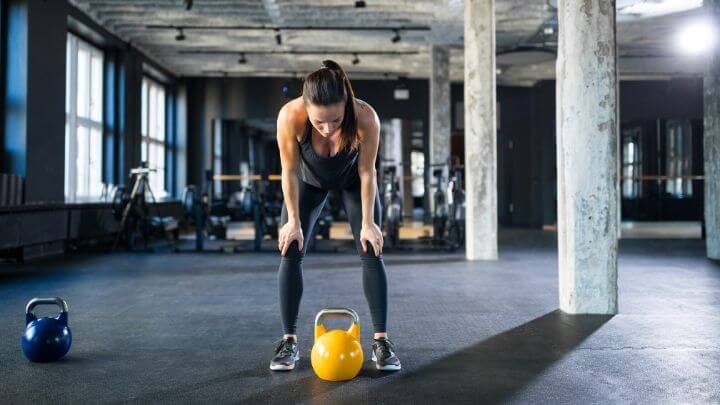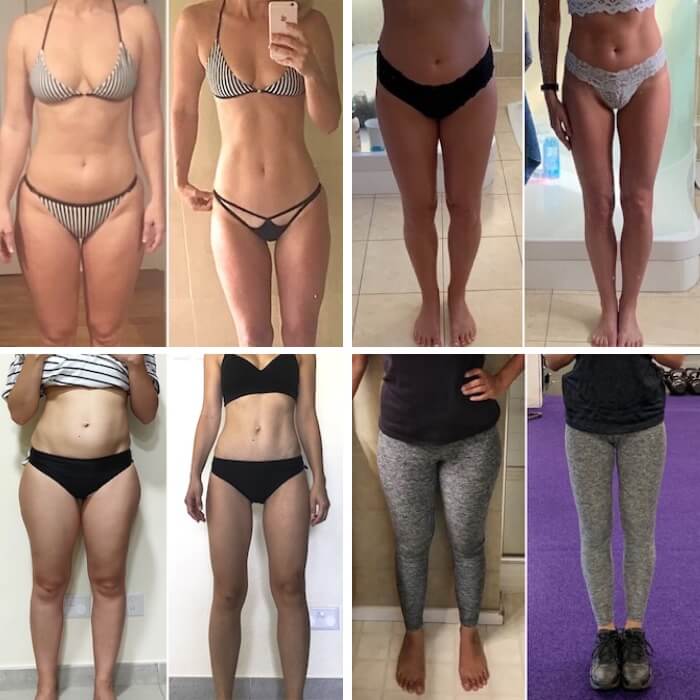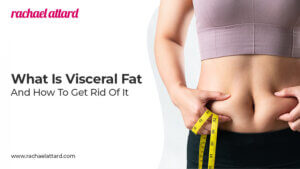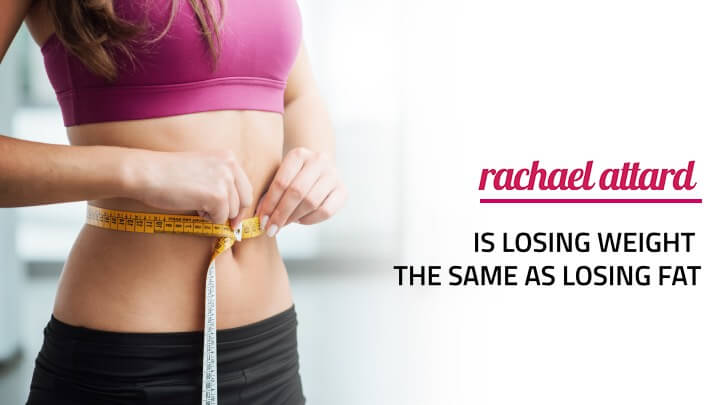Fat Burning Zone – Learn How to Burn More Fat

I want to help women achieve bodies that are healthy and that they are comfortable in. One of the ways I do this is by teaching women how to lose extra body fat and weight in the most efficient way.
I believe that getting your body in the fat burning zone is a great way to burn more fat.
In this blog post, I’ll explain what the fat burning zone is, how it works and the best way to exercise to lose fat fast.
DOES THE FAT BURNING ZONE REALLY WORK? THE SCIENCE BEHIND THE FAT BURNING ZONE THEORY
When you work out, most people think that you need to give the workout all the energy you have and to work out as hard as you can. After all, this is what makes you burn the most calories!
However, the fat burning zone theory says that you shouldn’t push your body all the way to 100. Instead, you’ll burn the most fat when you working at 60 to 70 percent of your maximum heart rate.
Basically, what this means, is that fat burning occurs when you limit the intensity of your workouts to a specific heart rate zone.
HOW YOUR BODY BURNS FAT AND CARBS
In order to understand how the fat burning zone works, we need to understand how the body burns fat.
Our bodies are constantly turning carbohydrates and fat into energy that we can use. This energy is called adenosine triphosphate, or ATP.
The ratio that your body uses carbs versus fat is going to depend on several things, including your activity level.
In general, though, our bodies are going to do what’s most efficient. In most situations, they are using a combination of fat and carbohydrates stored in our body to make energy and help us function.

WHY DOES MY BODY USE FAT DURING LOW-INTENSITY WORKOUTS?
Your body needs oxygen to convert fat into ATP. When you’re doing low to moderate-intensity exercise, you’re able to breathe easier and your body gets more oxygen than when you’re pushing hard in a HIIT or other intense workout.
The most efficient thing your body can do during lower and moderate forms of exercise is to turn to your stored fat into energy.
So according to the fat burning theory, you should do long low-intensity exercises in order to use up fat storage and to burn enough calories in order to see weight loss.
WHEN YOUR BODY USES CARBS FOR ENERGY
When you start to push your body into really hard workouts, your body needs to be able to find energy quickly. But when you’re working out hard and you’re struggling to breathe, your body doesn’t have enough oxygen to burn fat.
So instead, it turns to glycogen (or your body’s stored carbs) in order to get energy fast.
When you do a high-intensity workout, your body burns through your glycogen stores and may eventually turn back to fat burning depending on the length of the workout, and your body’s amount of stored carbs.
But if you eat before doing a high-intensity workout (and especially if your diet is high in carbs), your body will most probably burn way more carbs than fat.
WHAT ARE THE HEART RATE TRAINING ZONES?
There’s a direct connection between your heart rate and the intensity of your training. The harder you train, the faster your heart rate gets.
Depending on how hard you train, your heart rate can be in 5 different training zones.
For example, if you’re power walking for an hour, your heart is not going to pump as hard as it does when you’re doing something more intense like sprinting.
Knowing which zone you’re in will help you understand how your body is making energy and whether you’re burning mainly fat or carbs.
If you want to keep track of heart rate training zones, you need to know your maximum heart rate (more details below) and what each zone means.
Here are the 5 heart rate training zones and each of them can be estimated based on your heart rate!

1. HEART RATE ZONE 1 – WARM-UP ZONE
In this zone, you’re working out at <60 percent of your maximum heart rate.
Your heart rate is in this zone when you’re just moving around without doing anything remotely challenging.
It’s like when you’re rewatching Friends and going to the fridge to grab a piece of cake. ;)
2. HEART RATE ZONE 2 (FAT BURNING ZONE)
Just above the warm-up zone is your fat-burning zone. In this zone, you’re working out at about 60-70 percent of your maximum heart rate.
This level is all about endurance. Your body will be able to use oxygen to convert fat to energy, and you’ll find that you’ll be able to exercise for a while in this zone.
You’ve totally got this!
You’ll most likely be in this zone during low-intensity cardio like going to long power walks.
I have a really detailed blog post on how to use low-intensity cardio to burn more fat and get lean so make sure to give it a read. :)

3. HEART RATE ZONE 3 (CARDIO ZONE)
We’re picking up the pace here!
In this zone, you’re working out at about 70-80 percent of your maximum heart rate.
You should be able to talk and be relatively comfortable. However, you might find yourself sweating and breathing harder during this stage.
So it’s challenging but still doable!
In this zone, you’ve also reached what’s called the cardio zone. You start to burn a lot of calories relatively quickly in this zone.
The calories you burn here split evenly between your fat stores and glycogen (carbs). However, the fitter you are, the more your body will be able to rely on fat for energy, and not carbs (this is known as the anaerobic threshold).
Although you may not burn more fat than carbs, you will still burn lots of calories overall.
You’ll most likely get to the cardio zone when you’re jogging, swimming or cycling.
4. HEART RATE ZONE 4 (HIGH-INTENSITY ZONE)
Now we’re getting serious!
You’re working out at about 80 to 90 percent of your maximum heart rate.
You’re struggling to breathe and may find that it is becoming difficult to hold a conversation.
Over time, working out in this zone should help you to push harder or go faster.
Here you’re definitely burning tons of calories and more carbs than fat.
Resistance training is considered to be a high-intensity activity. Also, resistance training raises your metabolism which means you’ll burn more calories while resting.
So, even though it may not help you burn more fat, it will definitely help with weight loss and increasing your fitness.

5. INTENSE HEART RATE ZONE (MAXIMUM-INTENSITY ZONE)
This zone feels like when your PT tells you to push through the last 30 seconds of your 3 rounds of HIIT!
In this zone, you’re working out at about 90 to 100 percent of your maximum heart rate.
You’ll probably only be able to stand this zone for a few minutes. Your body’s respiratory and blood system will be working as hard as possible, and you’ll be panting and unable to talk.
Doing interval training in this zone (such as during a HIIT workout or sprinting) will make it easier for your body to burn both carbs and fat. You’ll also continue to burn calories after the workout is over, and your metabolism will temporarily increase.
If you’re new to exercising or haven’t done much high-intensity workouts, you might find that you can’t handle this intensity at all. So it’s important to listen to your body and take it easy.
HOW TO CALCULATE YOUR FAT BURNING ZONE
First, you’ll need to know your maximum heart rate. Your maximum heart rate = 220 minus your age. So for example, if you are 25 years old, your maximum heart rate is 220 – 25 = 195 beats per minute (bpm).
To calculate your fat burning zone of 60 to 70 percent of your maximum heart rate, follow these equations:
- Maximum heart rate x 0.6 (60%)
- Maximum heart rate x 0.7 (70%)

AN EXAMPLE
Here’s what this would be for a 25-year-old.
- Maximum heart rate = 220 – 25 = 195 beats per minute (bpm)
- 60% of your maximum heart rate is 195 x 0.6 = 117 bpm
- 70% of your maximum heart rate is 195 x 0.7 = 136.5 pm
So for a 25 year old person, the fat burning zone is when your heart rate is between 117 – 137 bpm.
If this is too technical for you, I recommend you try to just notice your body’s signs. In the fat burning zone, you should be able to talk and continue at the pace you’re going for at least an hour.
When I go for walks, I try to be in the fat burning zone as I’ve found this really helps to keep my legs slim.
I aim to walk at a medium-fast pace, and my heart rate is in the right zone. I don’t need to go full speed and feel really puffed out.
WHY YOU SHOULDN’T JUST STICK TO LOW-CARDIO WORKOUTS
Different types of workouts give your body different benefits. To help you see how they can do this, let’s imagine a few scenarios:
INTENSE WORKOUTS
Let’s imagine that after work, you decide to power through an intense HIIT workout or some resistance training.
This workout is intense, so your body needs a quick form of energy. Your body is struggling to use fat as an energy source because you’re breathing hard and aren’t getting enough oxygen to convert fat to energy.
But since you have eaten throughout the day, the carbs stored in your muscles are readily available, and your body doesn’t need oxygen to turn them into energy. You may eventually burn fat too, but the percentage of carbs burned will be higher than the percentage of fat.
This intense workout burns a ton of calories which is great for weight loss, helps boost your metabolism, and helps build some muscle that’s great for toning up.

LESS INTENSE WORKOUT
Now, let’s say it’s morning and you haven’t eaten yet. Your body is low on carbs and you decide to go for a power walk to start your day. This is called fasted cardio and it’s great for fat loss.
Your body isn’t being pushed too hard, so you’re getting plenty of oxygen. This, along with not having too many carbs in your body, means that your body starts to use fat for energy.
Fat is more abundant and is a great source of slow-burning energy which makes it perfect for the times like these.
Going for power walks and doing other low-intensity workouts is great for getting slim legs, it prevents burn out, and helps you recover from more intense workouts. :)
ACHIEVING THE BEST RESULTS!
Sticking to one form of exercise will prevent you from seeing the good results that the other forms can bring.
I believe the fat burning theory is based on scientific facts, but I still encourage you to do more than just low-intensity cardio. The best way to lose weight is to combine low and high-intensity cardio with resistance training. :)
This is why I designed my own workout program that combines fat burning exercises and resistance training. It’s designed to help you get lean and toned in just 8 weeks.
Here are some of the lovely girls who did my Lean Legs Program! :)
Love Rachael xx








Hello Rachael! I’m 21 and I’m medical student. I got to know about your program a year ago and it helped me a bit during quarantine. But now we have to go to our practical classes at the hospitals and I’m also working as a nurse. Every day I come home late and I feel really tired. That’s why I can do exercises at least 2-3 times a week.Have you got any useful tips for me? Should I,for example, do exercises 3 times a week, but more than 45 seconds or something like that? Please help me.
Hi lovely,
Thanks for reaching out!
Rachael wrote a few articles on how to stay healthy even with a busy schedule so feel free to give them a read. I’m sure that you’ll find them very useful. :)
FITNESS TIPS FOR BUSY WOMEN
5 WAYS TO STAY HEALTHY WITH A BUSY SCHEDULE
I hope that helps. If you have more questions, feel free to email us at info@rachaelattard.com
Love,
Len